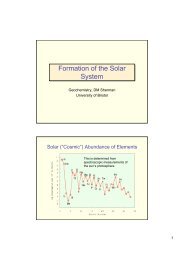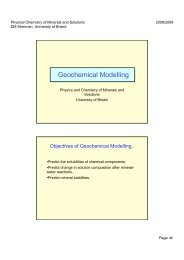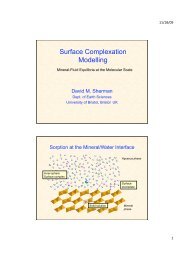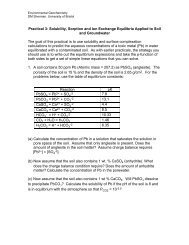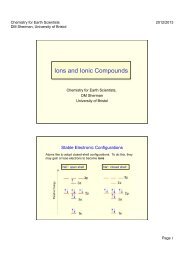Lecture Notes (PDF) - Aqueous and Environmental Geochemistry
Lecture Notes (PDF) - Aqueous and Environmental Geochemistry
Lecture Notes (PDF) - Aqueous and Environmental Geochemistry
- No tags were found...
You also want an ePaper? Increase the reach of your titles
YUMPU automatically turns print PDFs into web optimized ePapers that Google loves.
<strong>Environmental</strong> <strong>Geochemistry</strong>DM Sherman, University of Bristol2007/2008Acid Mine Drainage<strong>Environmental</strong> <strong>Geochemistry</strong>DM Sherman, University of BristolWhat is Acid Mine Drainage?• Pollution associated withab<strong>and</strong>oned mines resultingfrom the oxidation of FeS 2(pyrite).• Very acid streamwaters withmobilized heavy metals.• Some AMD is natural (themining industry prefers that itbe called “acid-rockdrainage”)Page 1
<strong>Environmental</strong> <strong>Geochemistry</strong>DM Sherman, University of Bristol2007/2008The Rio Tinto (Spain)SW Spain, mining activity for > 3000 years.Pyrite (FeS 2 )Pyrite is the most commonsulfide mineral <strong>and</strong> occursassociated with hydrothermalore deposits <strong>and</strong> in coalderived from marine deposits.In pyrite theoxidation state ofsulfur is -1 (S 2-2)Page 2
<strong>Environmental</strong> <strong>Geochemistry</strong>DM Sherman, University of Bristol2007/2008Pyrite/FeOOH Stability(species in italics are aqueous complexes)Acid Generation by S 22-OxidationOxidation of S2-2 generates H +FeS 2 (s) + (7/2)O 2 (g) + H 2 O →Fe 2+ + 2SO2-4 (aq) + 2H + (aq)Oxidation of S 2- does not generate H +CuFeS 2 (s) + 4O 2 (g) → Cu +2 + Fe 2+ + 2SO 42-(aq)FeS(s) + 2O 2 (g) → Fe 2+ + SO 42-(aq)ZnS(s) + 2O 2 (g) → Zn 2+ + SO 42-(aq)Page 3
<strong>Environmental</strong> <strong>Geochemistry</strong>DM Sherman, University of Bristol2007/2008Kinetics of Pyrite Oxidation by OxygenFeS 2 (s) + (7/2)O 2 (g) + H 2 O →Fe 2+ + 2SO 42-(aq) + 2H + (aq)rate (moles/m 2 -s) = 10 !8.10 [O 2] 0.5[H ] 0.11At pH 2.0 in air-saturated conditions [O 2 ] = 10 -3.6 mol/kg, t 1/2 = 16 years for 0.05m 2 /g.Evaporite Deposits of FeSO 4 Under acidic conditions,abiotic oxidation of Fe 2+ isslow. In the Rio Tinto,FeSO 4. nH 2 O precipitatesupon evaporation.Page 4
<strong>Environmental</strong> <strong>Geochemistry</strong>DM Sherman, University of Bristol2007/2008Other minerals that form…Coquimbite: Fe 2 (SO 4 ) 3 .H 2 O pK = 3.58Jarosite: KFe 3 (SO 4 ) 2 (OH) 6 pK = 93.2Alunite: KAl 3 (SO 4 ) 2 (OH) 6 pK = 85.6Anglesite: PbSO 4 pK = 7.76Gypsum: FeSO 4 .2H 2 O pK = 4.59Szomolnokite: FeSO 4 .H 2 O pK 0.91Kieserite: MgSO 4 .H 2 O pK = 0.12A possible Mars Analogue?The chemical composition of the martiansoil suggests weathering of pyrite.Jarosite has been identified from theMars Rover Mossbauer spectrometer.Page 5
<strong>Environmental</strong> <strong>Geochemistry</strong>DM Sherman, University of Bristol2007/2008Fe 2+ Oxidation facilitated by BacteriaThiobacillus ferrooxidansis the most importantbacteria that facilitates theoxidation of pyrite bygenerating Fe 3+ 4Fe 2+ (aq) + O 2 + 4H + → 4Fe 3+ (aq) + 4H 2 OThiobacillus ferrooxidans is acidophillic, autotropic <strong>and</strong>fixes its carbon from atmospheric CO 2 .Kinetics of Pyrite Oxidation by Fe 3+ FeS 2 (aq) + 14Fe 3+ (aq) + 8H 2 O(l) →15Fe 2+ (aq) + 2SO 42-(aq) + 16H + (aq)rate (moles/m 2 -s) = 10 !8.58 [Fe 3+ ] 0.3[Fe 2+ ] 0.47 [H ] 0.32At pH 2.0 with [Fe] tot = 10 -2 <strong>and</strong> [Fe 2+ ]/[Fe 3+ ] = 0.01,t 1/2 = 150 days for 0.05m 2 /g.Page 6
<strong>Environmental</strong> <strong>Geochemistry</strong>DM Sherman, University of Bristol2007/2008Pyrite Oxidation Summary(a) FeS 2 (s) + (7/2)O 2 (g) + H 2 O →Fe 2+ + 2SO 42-(aq) + 2H + (aq)Slow(b) 4Fe 2+ (aq) + O 2 + 4H + →4Fe 3+ (aq) + 4H 2 OVia Fe 2+ oxidizingchemolithoautotrophs(c) FeS 2 (aq) + 14Fe 3+ (aq) + 8H 2 O →15Fe 2+ (aq) + 2SO 42-(aq) + 16H + (aq)Fast, autocatalytic mechanismPrecipitation of FeOOHIron(III) (hydr)oxides precipitateout from solution when pH > 3.Goethite(α-FeOOH)Schwertmannite(Fe 8 O 8 (OH) 6 SO 4 )Page 7
<strong>Environmental</strong> <strong>Geochemistry</strong>DM Sherman, University of Bristol2007/2008Acid Mine Waste <strong>and</strong> Heavy MetalsAcid leaching <strong>and</strong> oxidation of galena (PbS), sphalerite(ZnS) <strong>and</strong> chalcopyrite (CuFeS 2 ) will release metalsinto solution.Secondary sulfates of Zn <strong>and</strong> Cu are quite soluble atlow pH. Secondary sulfates will limit the solubility ofPb:Anglesite: PbSO 4 (pK = 7.76)Beudantite: PbFe +3 (AsO 4 )(SO 4 )(OH) 6Beaverite: Pb(Fe,Cu) 3 (SO 4 ) 2 (OH) 6 Acid Mine Waste <strong>and</strong> Heavy MetalsAcid leaching <strong>and</strong> oxidation of galena (PbS), sphalerite(ZnS) <strong>and</strong> chalcopyrite (CuFeS 2 ) will release metalsinto solution.Metals concentrations (ppm) in Rio Tinto <strong>and</strong> Odiel RiverLocation pH Fe Cu Pb ZnBarrocal 2.5 5.8 415Cadea 2.58 5.6 64 0.5 1270Niebla 2.54 2.3 17 0.2 719The Rio Tinto/Huelva estuary provides up to 10% ofthe global riverine flux of Zn to the oceans!Page 8
<strong>Environmental</strong> <strong>Geochemistry</strong>DM Sherman, University of Bristol2007/2008Secondary Al phases from Acid WatersAcidic sulfate waters will react with primary aluminosilicateto give a complex series of Al hydroxy sulfates..3KAlSi 3 O 8 + 6H + + 2SO 4-2+ H 2 O→ 3Al(OH)(SO 4 ) + 6SiO 2 + 2K +Jurbanite3Al(OH)(SO 4 ) + K + + 3H 2 O= KAl 3 (OH) 6 (SO 4 ) 2 + SO 4-2+ 3H +AluniteKAl 3 (OH) 6 (SO 4 ) 2 + 3H 2 O = 3Al(OH) 3 + K + + 2SO 4-2+ 3H +GibbsiteSecondary Al phases from Acid WatersFlocculating Al(OH) 3Page 9
<strong>Environmental</strong> <strong>Geochemistry</strong>DM Sherman, University of Bristol2007/2008Remediation of Acid Mine Waste IA plausible method to deal with acid mine water would beto neutralize it using carbonate (Calcite, CaCO 3 ).2H + + CaCO 3 = Ca +2 + CO 2Trials of this method in CwmRheidol, Wales were notencouraging. A precipitate ofCaSO 4 formed on the surfaceof calcite <strong>and</strong> prevented theabove reaction.Sulphate-Reducing BacteriaThese bacteria live in soil <strong>and</strong>aquatic environments; they arestrict anaerobes <strong>and</strong> use(SO 4 ) 2- as an electron acceptor(“dissimilatory sulfatereduction”). Desulfovibrio <strong>and</strong> Desulfotomaculum are twoimportant genera.Page 10
<strong>Environmental</strong> <strong>Geochemistry</strong>DM Sherman, University of Bristol2007/2008Remediation of Acid Mine Waste IIArtificial wetl<strong>and</strong>s createanaerobic conditions sothat Desulfovibrio <strong>and</strong>Desulfotomaculumbacteria can reduce(SO 4 ) 2- <strong>and</strong> generateHCO 3- :2CH 2 O + SO 42-= H 2 S + 2HCO 3-(sulfate reduction)H 2 S + Cd 2+ = CdS + 2H + (heavy metal precipitation)Summary• Acid Mine Drainage results from the oxidation ofpyrite.• Iron oxidizing, acidophyllic bacteria promoteoxidation of dissolved Fe 2+ to Fe 3+ .• Oxidation of pyrite by Fe 3+ is fast.• Remediation can be done with artificial wetl<strong>and</strong>s topromote sulfate-reducing bacteria.Page 11



